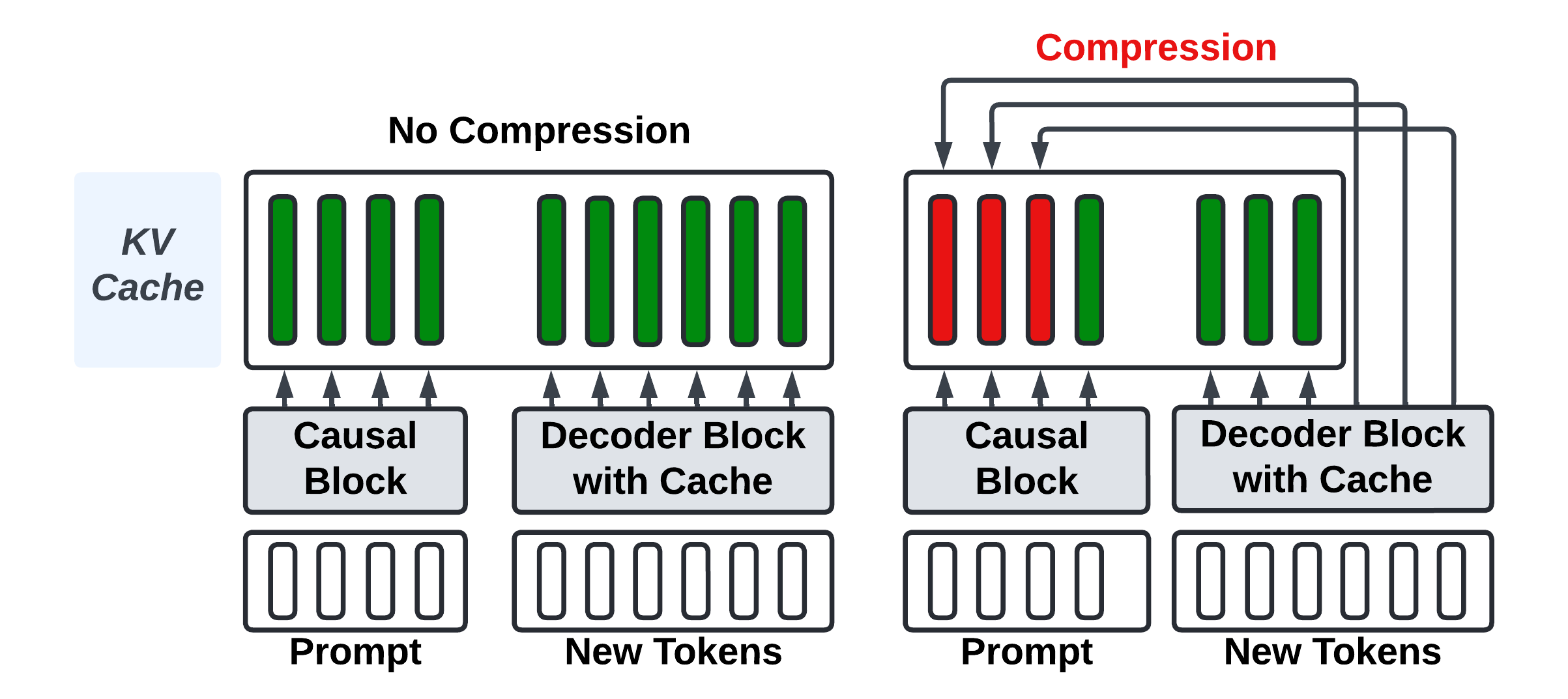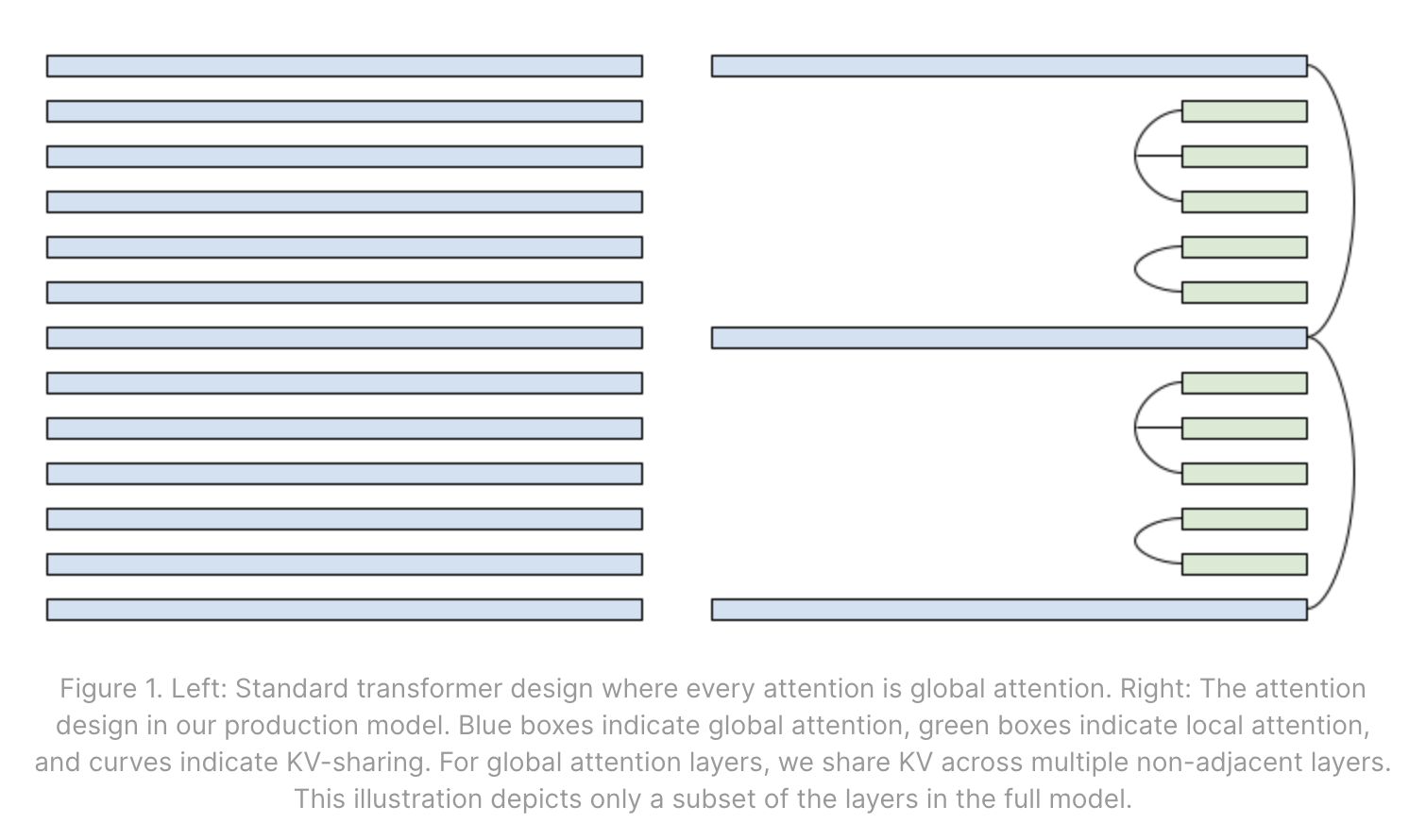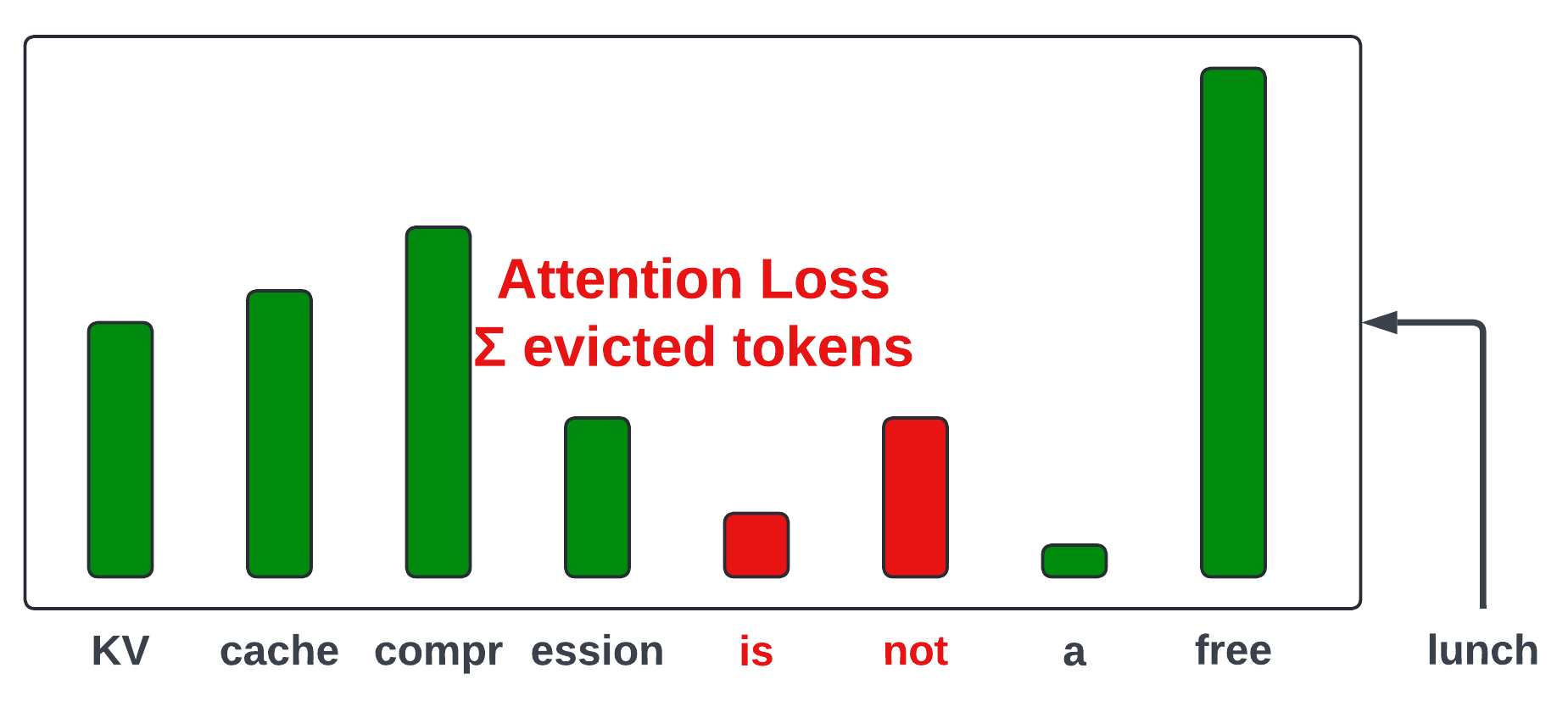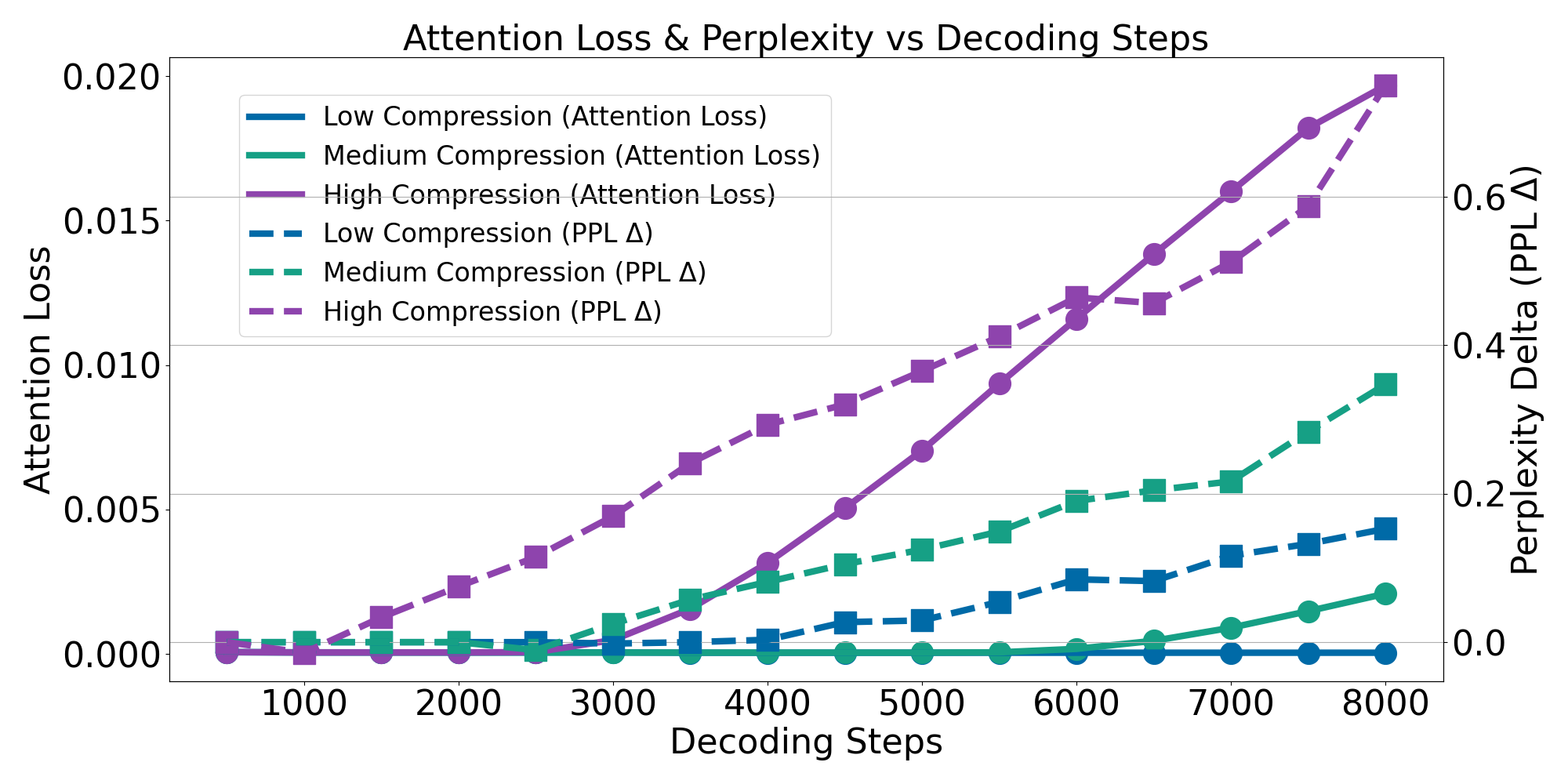Cold Compress is a hackable, lightweight, open source toolkit for creating, extending, and comparing KV cache compression methods.
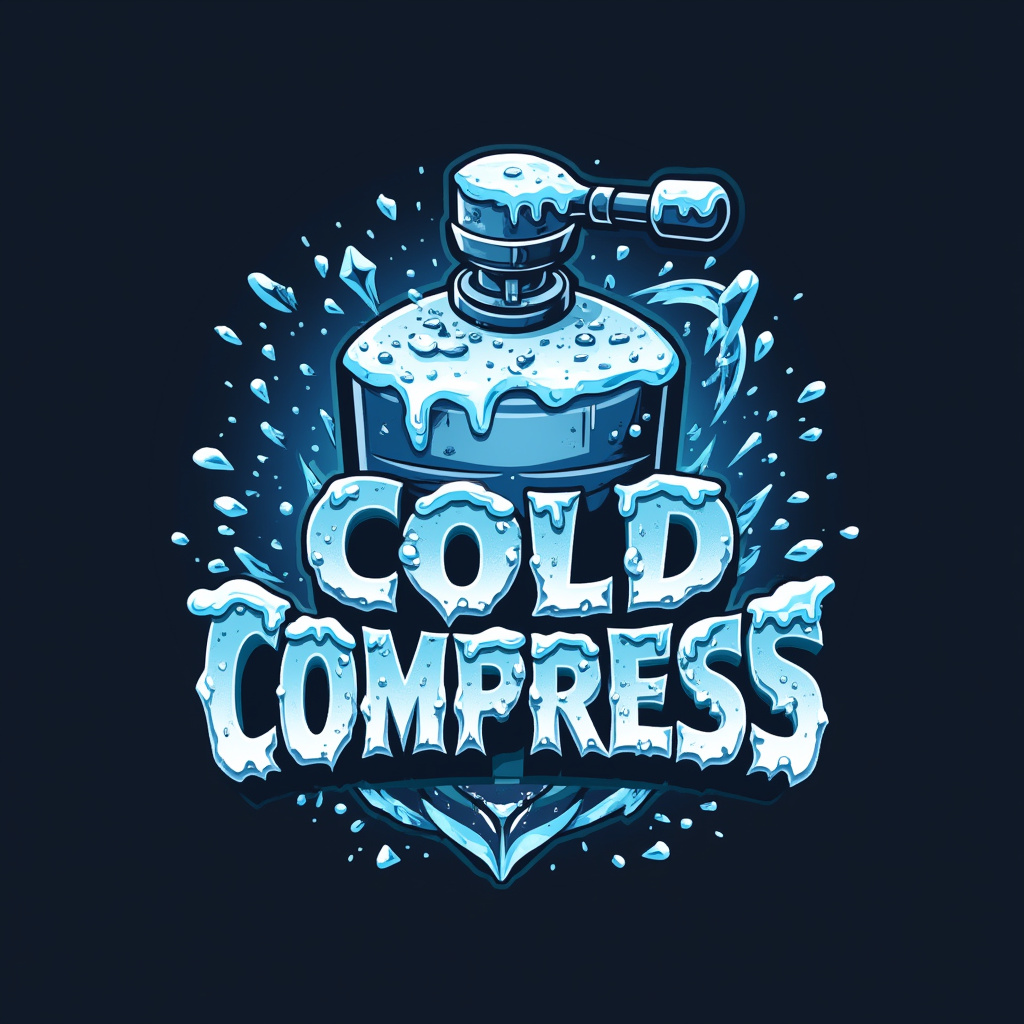
Logo for Cold Compress built with Flux.1
Created at Answer.AI, Cold Compress is built on top of GPT-Fast, a simple, PyTorch-native generation codebase. It takes advantage of torch.compile, which allows for GPU efficient code to be written in PyTorch without customized kernels.
Please see our blog post for a very deep dive into the KV Cache, cache compression, and the many SOTA strategies supported by Cold Compress.
Our initial release (Cold Compress 1.0) supports a wide set of popular approaches to KV cache compression, including:
- Attention-based evictions, e.g.,
Heavy Hitters - Sliding window attention, e.g.,
Recent Tokens - Preservation of attention sinks, e.g.,
Global Tokens - Layerwise customization, e.g.,
Pyramidshaped compression, alternatingLocal-Globalattention - Hybridization across attention heads, e.g.,
FastGen
Cold Compress implements existing methods, for which we make sure to give all the credit. Yet, to demystify these approaches, we use generic names to represent classes of existing methods (e.g., Heavy Hitter to cover {H20, Scissorhands, PyramidKV}).
The intended effect is that Cold Compress is easy to follow, customizable from the command line, and low effort to extend! The code should be able to be configured or slightly tweaked to exactly match existing methods.
pip install -r requirements.txt --extra-index-url https://download.pytorch.org/whl/nightly/After logging in with huggingface-cli login, run any of the following:
bash scripts/prepare_llama3.sh
bash scripts/prepare_llama2.sh
bash scripts/prepare_qwen2.shThis will download model and tokenizer files from HuggingFace for any one of Meta-Llama-3-8B-Instruct, meta-llama/Llama-2-7b-chat-hf or Qwen/Qwen2-7B-Instruct respectively and save them into a usable format inside ./checkpoints.
We are working on Meta-Llama-3.1-8B-Instruct, which is available with:
bash scripts/prepare_llama31.shYet is currently untested.
Please raise an issue or join our public Discord server if you would like to see more models supported or collaborate on new releases.
python generate.py --cache_strategy full --prompt "What is a cold compress?" --checkpoint_path ./checkpoints/meta-llama/Meta-Llama-3-8B-Instruct/model.pth
This will generate a response from a compiled Llama-3 with no cache compression (--cache_strategy full).
If you want to run on longer prompts, you can add it as a .txt file to ./prompts and run with python generate.py --prompt my_custom_prompt.txt. We've also pre-populated prompts with a few diverse prompts!
You can also run generate.py with the --compile flag which will compile the prefill and decoding functions.
Compilation takes a fairly long time (up to 5 minutes or more depending on the model), yet should only occur once or twice when generating multiple times.
For large-scale benchmarking (eval.py), we recommend running with --compile for 2-3x speedup gains, but for generate.py, run without compile for quicker one-time generations.
If you are noticing that --compile generations do not stabilize to a speed of about
To debug this, run your code with TORCHLOGS=recompiles to see what is causing the re-compilation.
It can be tricky to get debug so please feel free to raise any issues in our public Discord server if inference times are slow or your code isn't compiling.
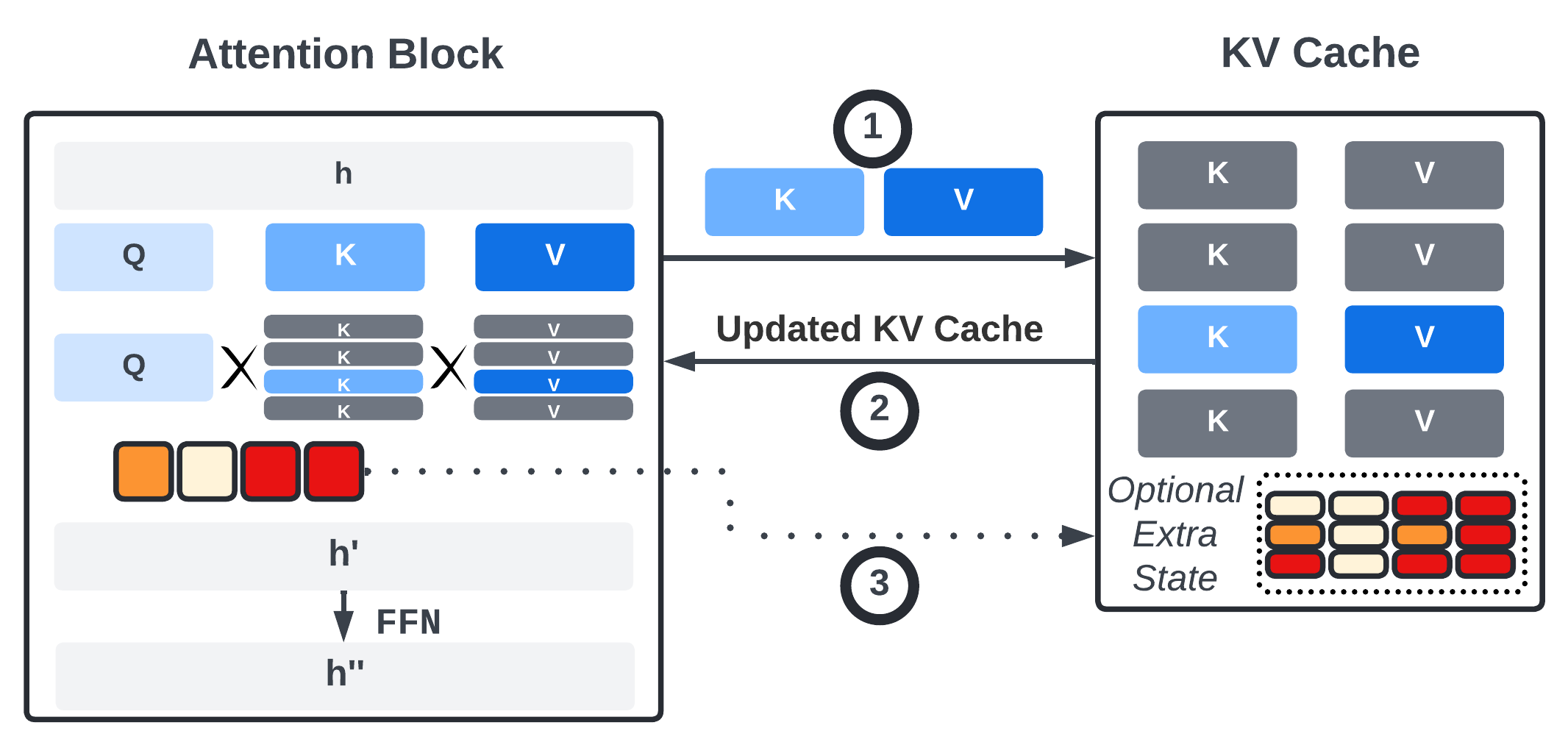 Capturing the flow of information between a model (attention) and the KV Cache.
Capturing the flow of information between a model (attention) and the KV Cache.
To use a compressed KV cache, specify a --cache_strategy other than "full", e.g., "recent_global", "heavy_hitter", "hybrid", "random", "l2".
Check out all the available cache strategies in def get_cache_constructor from cache.py.
Each cache strategy has a unique set of hyper-parameters controllable from the command line.
For instance, to customize sliding-window attention with a global attention sink (recent_global), check out its hyper-parameters by looking at the relevant_kwargs attribute of the KVCacheRecentGlobal class.
class KVCacheRecentGlobal(KVCacheHeadConstant):
relevant_kwargs = [
"max_cache_length",
"max_seq_length",
"global_tokens",
]
We can run:
python generate.py --prompt reverse_list.txt --cache_strategy recent_global --max_cache_length 16 --global_tokens 4 --prompt_compression_strategy recent_global
max_cache_length: size of the KV cache can be represented as a fraction of total sequence length (|prompt| + max_new_tokens) or as an integer> 1to set the exact size.global_tokens: the number of lead tokens to always keep in the KV cache. Lead tokens are attention sinks and should always be preserved.prompt_compression_strategy: the strategy for filtering tokens during prefill iff|prompt| > max_cache_length. Choose a strategy fromprompt_compression.py. Here, we chose a strategyrecent_globalto match our KV Cache strategy.
When you specify the cache size as a fraction, the actual cache size is computed as a fraction of maximum possible sequence length (|prompt| + max_new_tokens).
Yet, the actual compression ratio is computed as a fraction of the actual sequence length, which equals the |prompt| + |generation|.
If the actual generation is much shorter than the maximum allowable, you might notice lower than expected compression ratios.
To address this, you can set an absolute max cache length (>1) or, for generate.py, lower the --max_new_tokens to something closer to what you expect the model to generate.
It can be a pain to pass a long list of hyper-parameters via the command line.
To avoid this, you can create a Cache Config .yaml file instead under ./cache_configs.
We've pre-populated it with some configurations, including the recent_global strategy discussed above.
./cache_configs/recent_global.yaml
cache_strategy: ["recent_global"]
prompt_compression_strategy: ["recent_global"]
global_tokens: 4
We can then reduce the length of the above command:
python generate.py --prompt reverse_list.txt --checkpoint_path ./checkpoints/meta-llama/Meta-Llama-3-8B-Instruct/model.pth --max_cache_length 0.5 --cache_config recent_global
This can come in handy for strategies with many more hyper-parameters!
To store quantized KV values, add the flag --cache_bits {2,4,8}.
This is compatible with any cache strategy.
Empirically, little to no degradation occurs with --cache_bits {4,8} yet, as of now, 2-bit leads to a serious decline in the quality of generations.
Use generate.py to vibe test methods on individual prompts.
For benchmarking, use eval.py which supports evals on a growing list of long-context tasks: domain-specific (Dolomites), synthetic (RULER), QA (MuSiQue, TriviaQA, QuALITY), coding (RepoBench), summarization (QMSum, SQuALITY), and long generation (PG-19 book corpus).
Before running eval.py, make sure to set the ANTHROPIC_API_KEY environment variable if you want to use LLM-ROUGE (see below). Alternatively, comment out mentions of LLM-Rouge in task.py.
"LLM-Rouge": AutoMetric.from_name("llm-rouge"),
After doing this, you can run:
python eval.py --compile --cache_config hybrid --tasks dolomites rulerniah
It will apply the cache strategy specified in ./cache_configs/hybrid.yaml and test on Dolomites and RULER needle-in-a-haystack.
eval.py creates a directory based on the supplied cache arguments to dump the raw predictions and metrics for memory usage and task-specific performance.
See metric.py for a full list of supported metrics
For multiple-choice QA, we measure accuracy by comparing the loglikelihoods of generating each answer option, as in lm-eval-harness.
For free-text generation, we record standard reference-based metrics, ROUGE and BERTScore. Yet, given well documented limitations of these metrics, we focus on a new metric LLM-Rouge. LLM-Rouge prompts an LLM (Claude 3 Haiku) to judge the similarity of a model generated text with one or more ground-truths on a 1-5 LIKERT scale, using the following prompt format:
TEMPLATE = """You are shown ground-truth answer(s) and asked to judge the quality of an LLM-generated answer.
Assign it a score from 1-5 where 1 is the worst and 5 is the best based on how similar it is to the ground-truth(s).
Do NOT explain your choice. Simply return a number from 1-5.
====GROUND TRUTHS====
{labels}
====ANSWER====
{prediction}"""
PREFILL = "The score (1-5) is:"
We elicit Claude Haiku responses using Answer.AI's Anthropic wrapper Claudette.
As of now, GPT-Fast and, by extension, Cold Compress, only supports batch size one inference. (We are working on adding batched multi-GPU inference.)
To take advantage of multiple GPUs, we’ve written a script to parallelize eval jobs.
We've created two interfaces for parallelization:
The first is to provide a set of cache_configs, cache_sizes, and tasks which you’d like to evaluate, as shown below:
python parallelize_evals.py \
--config_names random l2 heavy_hitter recent_global \
--tasks truthfulqa rulerqa rulerniah rulervt rulercwe scrollsquality musique squality dolomites qmsum repobench \
--cache_sizes 0.75 0.5 0.25 0.1 0.05 \
--num_samples 500 \
--add_full \
--num_gpus 8 \
--checkpoint_path checkpoints/meta-llama/Meta-Llama-3-8B-Instruct/model.pth
This command will take the cartesian product of the config_names, tasks, and cache_sizes, and create the appropriate evaluation jobs and queue them across 8 GPU workers.
Alternatively, we can also pass in a text file consisting of individual evaluation commands, one per line, that need to be parallelized across the GPU workers:
python parallelize_evals.py \
--command_file experiments/eval_jobs.txt
--num_gpus 8
Prompts are processed in parallel with full self-attention. If |prompt| > max_cache_length, a PromptCompressor from prompt_compression.py removes |prompt| - max_cache_length tokens before pre-filling the cache.
If the |prompt| greatly exceeds the number of generated tokens, the impact of PromptCompressor strategy can dominate the results.
If you would like to focus on the impact of the KVCache strategy instead, you can run evals with --feed_long_prompts:
python eval.py --compile --cache_config hybrid --tasks dolomites rulerniah --feed_long_prompts
This will prefill the KV cache with the first max_cache_length prompt tokens before "feeding" the remaining |prompt| - max_cache_length to the decoder one-by-one. This will result in evictions being handled solely by the KVCache and not the PromptCompressor. This will reduce peak memory yet greatly slow down inference due to not fully parallelizing the prompt encoding. So, we recommend this flag purely for debugging.
A recent blogpost from Character.ai revealed the company’s strategies for bringing down LLM inference costs, which collectively, enable them to serve a whopping 20,000 queries per second! A focal point is reducing the size of the KV Cache.
In addition to using multi-query attention (MQA), they introduce two modifications:
- Alternating Local-Global layers
- Cross-Layer Attention: this is basically MQA with additional KV sharing across layers. Coming soon to Cold Compress!
Cache compression strategies emulating the Local-Global attention architecture is intriguing because it enables compression without losing the full history, which is preserved at certain layers.
In Cold Compress, Local-Global is just a mix of cache strategies (RecentGlobal and Full) across layers:
python eval.py --compile --cache_config local_global.yaml
Which sets the following args:
cache_strategy: ["recent_global", "full"]
cache_strategy_pattern: "repeat" # or tile
max_cache_length: [0.25, 1.0]
cache_length_pattern: "repeat" # or tile
prompt_compression_strategy: ["recent_global", None]
global_tokens: 4
We set a dynamic strategy by passing a list of strategies to cache_strategy and then control the pattern by setting cache_strategy_pattern to “repeat” which alternates the two. “tile” sets the first N // 2 layers to full and the final N // 2 layers to full.
You can pass in a cache_strategy of any length, provided it is a factor of the number of layers in the model (32 for Llama-3-8B).
You can run a pre-configured set of local-global experiments with:
bash experiments/local_global.yaml
There is no consensus regarding the optimal allocation of a KV cache budget across layers.
While PyramidKV proposes increasing compression at higher layers, ScissorHands advocates for the opposite. ScissorHands finds that Heavy Hitters are more variable at higher layers, so larger caches are needed to reduce cache misses.
Most other work proposes a uniform cache size across layers.
We introduce --cache_length_pattern to enable experimentation around this important hyper-parameter.
To use a pyramid cache pattern, you can set --cache_length_pattern pyramid.
Alternatively, --cache_length_pattern funnel will invert this, using greater cache sizes at later layers.
The value passed for --max_cache_length represents the average cache size for pyramids and funnels.
The default for cache length pattern is tile, which tiles the cache size pattern provided to match the model depth.
python eval.py --compile --cache_strategy recent_global --max_cache_length 0.1 0.5 –cache_length_pattern tile
Assigns a cache size of 0.1 to the first L // 2 layers and 0.5 to the second half. To alternate, set:
python eval.py --compile --cache_strategy recent_global --max_cache_length 0.1 0.5 –cache_length_pattern repeat
You can kick off a pre-defined set of experiments for length customization by running
bash experiments/dynamic_length.sh
To better understand why one method may work better than another, it is important to understand the intrinsic cost of compression.
Specifically, it’s nice to be able to understand the deviation from the full attention caused by token dropping. As defined in L2-Norm and FastGen, we compute the attention loss as the sum of the attention probabilities for the evicted tokens.
To calculate the Attention Loss, we need to keep all tokens in the KVCache, e.g., set cache strategy to full, while simulating evictions for a compressed cache.
To do this, we create a new class KVCacheAnalysis which is invoked when the cache strategy is prepended with the string debug:
python eval.py --compile --cache_strategy debug_scissor
A handful of debugging experiments can be kicked off by running:
bash experiments/attention_loss.sh
These experiments record Attention Loss at various decoding steps. From these experiments, which record PPL on the PG-19 Book Corpus, we can show a clear correlation between Attention Loss and downstream performance (PPL).
This suggests that Attention Loss might be an decent proxy to approximate downstream degradation from compression.
We’ll walk through the process of creating a made-up cache eviction strategy called KVCacheKeepItOdd.
KVCacheKeepItOdd is funky! It only keeps odd-indexed token positions, in addition to the first --global_tokens) and the most recent --recent_window).
In cache.py we’ll create a new class (KVCacheKeepItOdd), add it to the registry of caches (get_cache_constructor), and make it available as a command-line arg in add_cache_arguments.
def add_cache_arguments(parser: argparse.ArgumentParser):
...
strategies = [..., "keep_it_odd"]
...
class KVCacheKeepItOdd(KVCacheHeadConstant):
...
def get_cache_constructor(cache_strategy):
...
elif cache_strategy == "keep_it_odd":
cls = KVCacheKeepItOdd
Next, we’ll have to write a _token_importances function to implement our funky strategy:
class KVCacheKeepItOdd(KVCacheHeadConstant):
relevant_kwargs = [
"max_cache_length",
"max_seq_length",
"global_tokens",
"recent_window",
]
def __init__(
self, max_batch_size, n_heads, head_dim, dtype=torch.bfloat16, **kwargs
):
super().__init__(max_batch_size, n_heads, head_dim, dtype, **kwargs)
def _token_importances(self, input_pos):
scores = torch.zeros_like(self.pos[:, 0], dtype=torch.bfloat16)
scores[self.pos[:, 0] % 2 == 1] = 1.0
scores[self.pos[:, 0] >= input_pos - self.recent_window] = float("inf")
return scores
Now that we have a Keep-It-Odd cache strategy, we need to figure out what to do when the prompt sequence length is greater than the specified cache size.
We can use an existing prompt compression method by passing in --prompt_compression_strategy recent_global, or we can create a new one which also implements our odd logic.
To do this, we will create a PromptCompressorKeepItOdd class in prompt_compression.py:
class PromptCompressorKeepItOdd(PromptCompressorHeadConstant):
"""
A toy example of a prompt compressor that keeps the odd positions indices of the prompt.
"""
def __init__(self, head_specific, **kwargs) -> None:
super().__init__(head_specific, **kwargs)
def _token_importances(self, input_pos, k_val, v_val, **kwargs):
seq_len = input_pos.shape[-1]
# Compute odd indices from keep_idxs to input_pos.shape[-1] - window
priority = input_pos.masked_fill(
self._recent_global_mask(input_pos),
seq_len * 2
)
# Lower the priority of even tokens
priority[input_pos % 2 == 0] -= seq_len
return priority
The prompt compressor applies the same selection logic as KVCacheKeepItOdd: keep odd positions, recent tokens, and global tokens.
The prompt compressor is responsible for filtering the prompt down to the max cache length.
This new strategy can now be used from the command line:
python eval.py --compile --cache_strategy keep_it_odd --prompt_compression_strategy keep_it_odd --global_tokens 4 --recent_window 10 --max_cache_length 0.5
To avoid passing in arguments to the command line each time, you can write a ./cache_configs/keep_it_odd.yaml file:
cache_strategy: ["keep_it_odd"]
prompt_compression_strategy: ["keep_it_odd"]
recent_window: 10
global_tokens: 4
And run with just:
python eval.py --compile --cache_config keep_it_odd --max_cache_length 0.5
We’ve supported several long context benchmarks and are continuing to add tasks.
Adding a new task is simple. We’ll walk through an example of adding the popular CNN/Dailymail summarization dataset. In task.py, we’ll create a new class called CNNDailyMail which inherits from the abstract EvaluationTask.
We need to provide a DEFAULT_PROMPT_TEMPLATE that will be used to prompt the LLMs for evaluating this task. We will also set a max_token limit of 256 since we want concise summaries. This argument is important because this will be used to determine the maximum size of the cache (along with the input prompt length).
Since our dataset is on HuggingFace, we can simply pass hf_args during initialization, and the base class will fetch the dataset from HuggingFace datasets. If your dataset is not on HuggingFace datasets, you can always overwrite the _download() method to download the dataset from elsewhere.
The final thing we need to do during initialization is specify the metrics that will be used for this task. In this case, we will use ROUGE, which is the most commonly used metric for this task.
class CNNDailyMail(EvaluationTask):
DEFAULT_PROMPT_TEMPLATE = """You will be shown a news article. Your task to carefully read the article and summarize the main points concisely.
====NEWS ARTICLE====
{article}
"""
def __init__(
self, prompt_template=DEFAULT_PROMPT_TEMPLATE, max_tokens=256, **kwargs
):
super().__init__(
prompt_template, max_tokens,
hf_args=["abisee/cnn_dailymail", "3.0.0"], **kwargs
)
# See full list of metrics in metric.py
self.metrics = {
"Rouge": AutoMetric.from_name("rouge"),
}
Next, we need to provide an implementation for the abstract method prepare_row, which will process a single item in the dataset and return either a single dict or a list of dicts. The returned dict must contain the following keys: context, question, prompt, and labels. Not all tasks will have a different question for each sample, as is the case with our task. In this case we will simply provide a dummy question for the task. The prompt is what will be used to prompt the LLM for the response, and the labels will be used to evaluate the model generation.
def prepare_row(self, row: dict):
article = row["article"]
highlights = row["highlights"]
prompt = self.prompt_template.format(article=article)
return {
"context": article,
"question": "Summarize the main points concisely.",
"prompt": prompt,
"labels": highlights,
}
Finally, we need to register the task by adding it to the TASK_MAPPING dictionary with a friendly string label, as shown below:
TASK_MAPPING = {
...
"cnndm": CNNDailymail,
}
That’s it! The task is now available as a command-line arg via python eval.py --compile --tasks cnndm.
We'd love for you to get involved and collectively aim to improve Cold Compress for future releases. There are various ways to get involved:
- Participate in discussions of KV Cache Compression on our public Discord server.
- Raise an issue for something you'd like to see fixed, improved, or built.
- Or, issue a Pull Request with code you'd like added.
- [Coming Soon] Submit a new KV Cache compression method via a PR which we will run and add to our Leaderboard.
We are actively exploring supporting the following in Cold Compress:
- GIST tokens.
- CPU offloading of ``evicted'' tokens, e.g., InfLLM.
- Cross Layer Attention.
- Bayesian optimization to find optimal hybrid strategies.
- KV-Cache Lite Architectures, e.g., YOCO, GoldFinch, Infini-attention, LoMA, Block Transformer.
- Importance-aware quantization
We are actively exploring the following enhancements to our evaluation benchmarks:
- New metrics and datasets to capture areas of regression that existing benchmarks might otherwise overlook.
- Synthetic tasks with abrupt topic shifts to pressure test token dropping.
- A better understanding of the impact of attention loss on downstream loss.
We are interested in adding support for:
- Batched, multi-GPU inference.
- Recently released
FlexAttentionfrom PyTorch.
Cold Compress implements methods introduced in existing work. If you use it in your work, please make sure to cite the GPT-Fast blogpost and our own:
@misc{gpt-fast,
title={Accelerating generative ai with pytorch ii: Gpt, fast.},
author={Team PyTorch},
year={2023},
url={https://pytorch.org/blog/accelerating-generative-ai-2/}
}
@misc{cold-compress-2024,
title={Cold Compress: A Toolkit for Benchmarking KV Cache Compression Approaches},
author={Adams, Griffin and Ladhak, Faisal and Schoelkopf, Hailey, and Biswas, Raja},
month=8,
year=2024,
version={v1.0},
url={https://www.answer.ai/posts/2024-08-01-cold-compress.html}
}
But more importantly, please cite the following works that correspond to the methods you used:
--cache_strategy recent_global, --prompt_compression_strategy recent_global
@article{child2019generating,
title={Generating long sequences with sparse transformers},
author={Child, Rewon and Gray, Scott and Radford, Alec and Sutskever, Ilya},
journal={arXiv preprint arXiv:1904.10509},
year={2019}
}
@article{beltagy2020longformer,
title={Longformer: The long-document transformer},
author={Beltagy, Iz and Peters, Matthew E and Cohan, Arman},
journal={arXiv preprint arXiv:2004.05150},
year={2020}
}
@article{xiao2023efficient,
title={Efficient streaming language models with attention sinks},
author={Xiao, Guangxuan and Tian, Yuandong and Chen, Beidi and Han, Song and Lewis, Mike},
journal={International Conference on Learning Representations (ICLR) 2024},
year={2024}
}
--cache_strategy heavy_hitter
@article{zhang2024h2o,
title={H2o: Heavy-hitter oracle for efficient generative inference of large language models},
author={Zhang, Zhenyu and Sheng, Ying and Zhou, Tianyi and Chen, Tianlong and Zheng, Lianmin and Cai, Ruisi and Song, Zhao and Tian, Yuandong and R{\'e}, Christopher and Barrett, Clark and others},
journal={Advances in Neural Information Processing Systems},
volume={36},
year={2024}
}
@article{zhang2024pyramidkv,
title={PyramidKV: Dynamic KV Cache Compression based on Pyramidal Information Funneling},
author={Zhang, Yichi and Gao, Bofei and Liu, Tianyu and Lu, Keming and Xiong, Wayne and Dong, Yue and Chang, Baobao and Hu, Junjie and Xiao, Wen and others},
journal={arXiv preprint arXiv:2406.02069},
year={2024}
}
@article{liu2024scissorhands,
title={Scissorhands: Exploiting the persistence of importance hypothesis for llm kv cache compression at test time},
author={Liu, Zichang and Desai, Aditya and Liao, Fangshuo and Wang, Weitao and Xie, Victor and Xu, Zhaozhuo and Kyrillidis, Anastasios and Shrivastava, Anshumali},
journal={Advances in Neural Information Processing Systems},
volume={36},
year={2024}
}
@article{anagnostidis2024dynamic,
title={Dynamic context pruning for efficient and interpretable autoregressive transformers},
author={Anagnostidis, Sotiris and Pavllo, Dario and Biggio, Luca and Noci, Lorenzo and Lucchi, Aurelien and Hofmann, Thomas},
journal={Advances in Neural Information Processing Systems},
volume={36},
year={2024}
}
--prompt_compression_strategy heavy_hitter
@article{li2024snapkv,
title={Snapkv: Llm knows what you are looking for before generation},
author={Li, Yuhong and Huang, Yingbing and Yang, Bowen and Venkitesh, Bharat and Locatelli, Acyr and Ye, Hanchen and Cai, Tianle and Lewis, Patrick and Chen, Deming},
journal={arXiv preprint arXiv:2404.14469},
year={2024}
}
--cache_strategy l2, --prompt_compression_strategy l2
@article{devoto2024simple,
title={A Simple and Effective $ L\_2 $ Norm-Based Strategy for KV Cache Compression},
author={Devoto, Alessio and Zhao, Yu and Scardapane, Simone and Minervini, Pasquale},
journal={arXiv preprint arXiv:2406.11430},
year={2024}
}
--cache_strategy hybrid
@article{ge2023model,
title={Model tells you what to discard: Adaptive kv cache compression for llms},
author={Ge, Suyu and Zhang, Yunan and Liu, Liyuan and Zhang, Minjia and Han, Jiawei and Gao, Jianfeng},
journal={International Conference on Learning Representations (ICLR) 2024},
year={2024}
}
@article{jiang2024minference,
title={MInference 1.0: Accelerating Pre-filling for Long-Context LLMs via Dynamic Sparse Attention},
author={Jiang, Huiqiang and Li, Yucheng and Zhang, Chengruidong and Wu, Qianhui and Luo, Xufang and Ahn, Surin and Han, Zhenhua and Abdi, Amir H and Li, Dongsheng and Lin, Chin-Yew and others},
journal={arXiv preprint arXiv:2407.02490},
year={2024}
}
--cache_length_pattern {pyramid,funnel}
@article{zhang2024pyramidkv,
title={PyramidKV: Dynamic KV Cache Compression based on Pyramidal Information Funneling},
author={Zhang, Yichi and Gao, Bofei and Liu, Tianyu and Lu, Keming and Xiong, Wayne and Dong, Yue and Chang, Baobao and Hu, Junjie and Xiao, Wen and others},
journal={arXiv preprint arXiv:2406.02069},
year={2024}
}
@article{liu2024scissorhands,
title={Scissorhands: Exploiting the persistence of importance hypothesis for llm kv cache compression at test time},
author={Liu, Zichang and Desai, Aditya and Liao, Fangshuo and Wang, Weitao and Xie, Victor and Xu, Zhaozhuo and Kyrillidis, Anastasios and Shrivastava, Anshumali},
journal={Advances in Neural Information Processing Systems},
volume={36},
year={2024}
}
--cache_strategy [{recent_global, heavy_hitter, ...}, full] --cache_strategy_pattern {tile,repeat}
@article{beltagy2020longformer,
title={Longformer: The long-document transformer},
author={Beltagy, Iz and Peters, Matthew E and Cohan, Arman},
journal={arXiv preprint arXiv:2004.05150},
year={2020}
}
@online{
gemma2,
author={Gemma Team, Google DeepMind},
url={https://storage.googleapis.com/deepmind-media/gemma/gemma-2-report.pdf},
year={2024}
}
